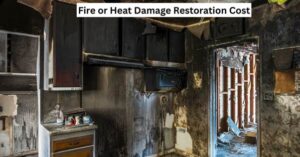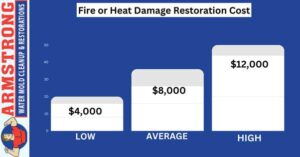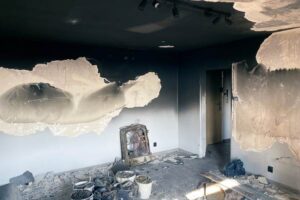
Don’t let fire or heat damage burn through your savings—discover affordable restoration solutions today!
Dealing with fire or heat damage can feel overwhelming, but understanding the costs involved makes the process more manageable. Whether it’s smoke cleanup, structural repairs, or odor removal, knowing the fire or heat damage restoration cost ensures you can plan and restore your property efficiently. Let’s break down the costs so you can make informed decisions.
Cost breakdown Heat Damage Restoration
| Cost Category | Price Range |
| Low Cost | $4,000 |
| Average Cost | $8,000 |
| High Cost | $12,000 |

Facing fire or heat damage? Uncover the costs and plan your restoration journey today!
| Service | Average Cost |
| Initial Inspection and Assessment | $200 – $600 |
| Smoke and Soot Removal | $500 – $3,500 |
| Structural Repairs | $1,500 – $10,000 |
| Water Extraction and Drying | $1,000 – $4,500 |
| Fire Odor Removal and Deodorization | $300 – $2,000 |
| Content Cleaning and Restoration | $500 – $7,500 |
| Full-Scale Reconstruction | $10,000 – $50,000+ |
| Emergency Board-Up Services | $150 – $750 |
Introduction
Fire or heat damage can have devastating effects on your property, but professional restoration is key to rebuilding. Understanding the fire or heat damage restoration cost is essential to budgeting effectively. With varying fire or heat damage restoration prices and services, homeowners must know what factors impact the fire or heat damage restoration charges and how the cost of fire or heat damage restoration is calculated.
Types of Heat or Fire Damage Restoration
Structural Repairs
After a fire, the structural integrity of your property may be compromised. This type of restoration involves repairing or replacing damaged walls, ceilings, floors, and roofing to ensure your home is safe and stable again.
Smoke and Soot Removal
Smoke and soot can infiltrate every part of your home, including walls, furniture, and air ducts. Specialized cleaning techniques are used to remove these contaminants and prevent long-term odors and health risks.
Water Extraction and Drying
Firefighting efforts often leave behind water damage, which can lead to mold growth. Water extraction and drying services remove excess moisture and prevent further damage to your property.
Content Cleaning and Restoration
Personal items, electronics, and furniture can be cleaned and restored after a fire. This process helps recover valuable possessions and minimizes replacement costs.
Odor Removal and Deodorization
Persistent smoke odors can linger for weeks after a fire. Advanced techniques, such as ozone treatment or thermal fogging, are used to eliminate these odors and restore indoor air quality.
Causes of Heat or Fire Damage Restoration
Fire and heat damage often occur due to a variety of causes, including electrical malfunctions, cooking accidents, heating system failures, or natural disasters like wildfires. In some cases, even small fires can result in significant damage, especially if they spread quickly or go unnoticed. The primary cause of the need for restoration is the destruction of property and the spread of smoke and soot, which can affect both the structure and contents of a home or building.
Effects of Heat or Fire Damage Restoration
The effects of fire and heat damage are far-reaching, causing immediate and long-term issues. Structural damage can compromise the safety of the building, while smoke and soot can linger in the air and on surfaces, posing health risks. Water used in firefighting efforts can also lead to mold growth. Restoration efforts aim to address these issues by repairing the structure, removing contaminants, drying affected areas, and eliminating odors. Failure to restore the property properly can lead to further damage, increased repair costs, and health hazards for residents.
Factors that impact the cost of fire or heat damage restoration
| Factor | Impact on Cost | Explanation |
| Severity of Damage | Higher costs for extensive damage | The more severe the fire or heat damage, the more repairs and restoration are needed, increasing costs. |
| Size of the Property | Larger properties cost more | Bigger properties require more materials, labor, and time to restore, which increases overall costs. |
| Type of Damage (Structural vs. Content) | Structural repairs are typically more expensive than content cleaning | Structural repairs (walls, ceilings, flooring) require significant work, while content cleaning may be cheaper. |
| Water Damage from Firefighting | Additional costs for water extraction and drying | Water used in firefighting efforts can cause additional damage, requiring extra services for removal and drying. |
| Location | Costs may vary based on regional labor rates and availability of materials | Restoration costs can vary depending on the geographic area and local market conditions. |
| Time of Restoration | Emergency restoration services are often more expensive | Immediate or emergency restoration services are typically more expensive due to expedited work. |
| Type of Fire (Residential vs. Commercial) | Commercial properties typically incur higher costs | Commercial properties often involve more complex systems, larger spaces, and more extensive restoration needs. |
| Specialized Services | Advanced services like odor removal or electronics restoration add costs | Techniques like ozone treatments for odor removal or specialized cleaning for electronics increase expenses. |
| Insurance Coverage | Varies based on the insurance policy and deductible | Insurance can reduce out-of-pocket costs, but coverage limits and deductibles can affect the final restoration price. |
Fire or heat damage? Learn the costs, save smart, and rebuild better with expert insights!
Fire or Heat Damage Restoration Cost vs other types of fire restoration cost
| Service Type | Average Cost (USD) | Description |
| Structural Fire Damage Restoration cost | $6,000 – $15,000 | Includes repairing or replacing walls, ceilings, floors, and insulation affected by fire or heat. |
| Contents Fire Damage Restoration cost | $1,500 – $5,000 | Restores furniture, electronics, clothing, and personal belongings affected by smoke, soot, or heat. |
| Electrical Fire Damage Restoration cost | $3,500 – $12,000 | Repairs or replaces electrical systems, wiring, and appliances damaged by fire. |
| Third-Party Fire Damage Restoration cost | $10,000 – $25,000 | Cost for hiring independent professionals to oversee and manage the fire restoration process. |
| Fire or Heat Damage Restoration cost | $4,000 – $12,000 | Focuses on repairing areas affected by intense heat, even if not directly on fire. |
| Smoke Damage Restoration cost | $2,000 – $6,000 | Cleaning and deodorizing smoke residue from walls, furniture, and fabrics. |
| Air Quality Restoration cost | $1,500 – $4,000 | Removes airborne contaminants and odors from the building, ensuring safe air quality post-fire. |
Sum up

Dealing with fire or heat damage can be a daunting experience, but understanding the costs involved is key to making informed decisions about restoration. From structural repairs and smoke removal to water extraction and odor deodorization, various services impact the final fire or heat damage restoration cost. Knowing the factors that affect pricing, such as severity, property size, and service type, can help you better budget for the recovery process.
If you’re facing fire or heat damage and need expert help, don’t hesitate to contact us for a consultation. Our specialists can guide you through the process, providing a clear estimate based on your specific needs and location.
FAQs
Factors like damage severity, property size, and location influence the cost.
The average cost ranges from $4,000 to $12,000, depending on the damage.
Insurance may cover restoration costs, but coverage limits and deductibles apply.
The timeline depends on the damage, typically taking a few days to several weeks.
Professional restoration is recommended for safety and thoroughness.
